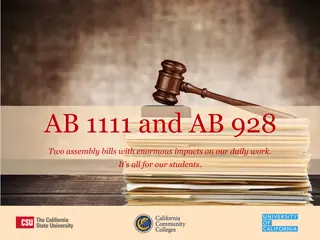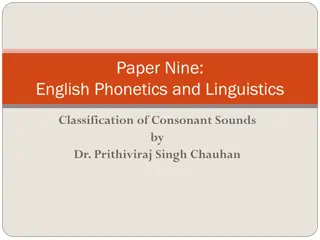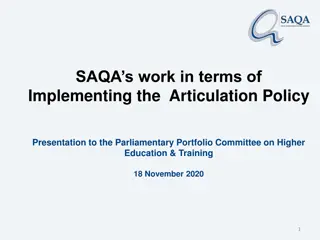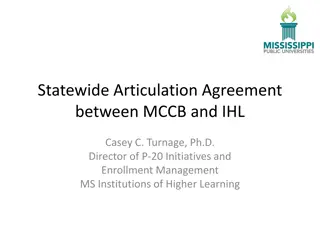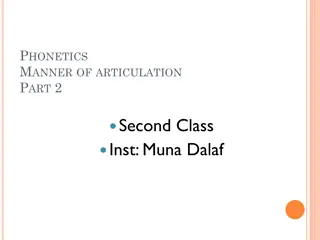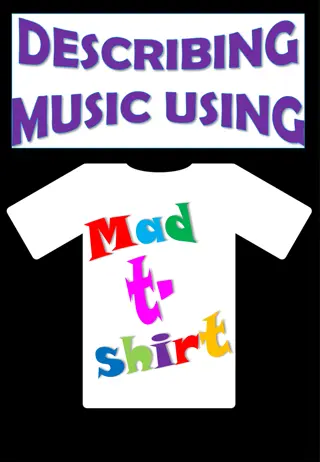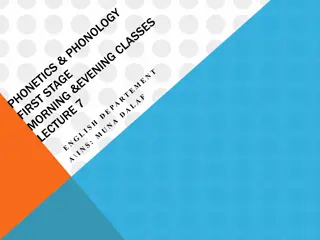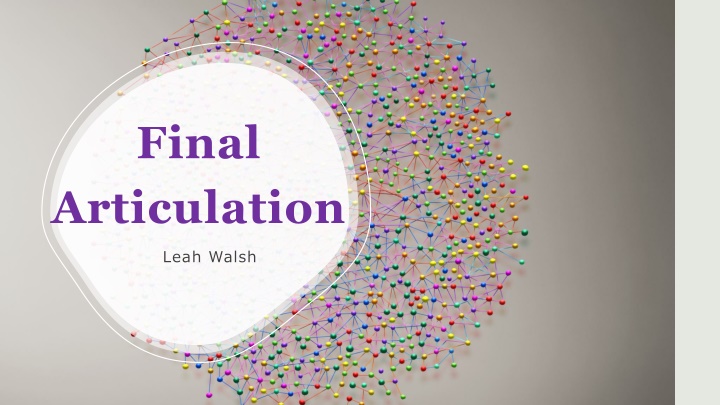
Leah Walsh's Higher Education Journey: Reflections and Challenges
Follow Leah Walsh's reflections on her higher education journey, from early struggles with course expectations to the importance of saving work periodically. Discover insights from her experiences in courses like Electronic Health Records and Clinical Documentation.
Download Presentation

Please find below an Image/Link to download the presentation.
The content on the website is provided AS IS for your information and personal use only. It may not be sold, licensed, or shared on other websites without obtaining consent from the author. If you encounter any issues during the download, it is possible that the publisher has removed the file from their server.
You are allowed to download the files provided on this website for personal or commercial use, subject to the condition that they are used lawfully. All files are the property of their respective owners.
The content on the website is provided AS IS for your information and personal use only. It may not be sold, licensed, or shared on other websites without obtaining consent from the author.
E N D
Presentation Transcript
Final Articulation Leah Walsh
Final Articulation: Introduction- Leah Walsh Looking back at where I began in my higher education journey and where I am today, I can see that I have come a long way. I didn t always take the easiest route, although I am always telling others to work smarter not harder. When I sat back and really dug deep into what the course expectations and institutional expectations, I think I may have really short-changed myself and my instructors when categorizing my e-portfolio submissions. I for one, did not quite understand exactly how the organization of numbering system worked, I didn t know if I was to choose which out-comes I felt I met and then after the instructor graded my submission the instructor was to select which out-come they felt I had achieved at that point. I did not quite figure out the whole process of this system until just this final semester. With that being said, I would like to give you some information on which outcome I had initially chosen and which outcome I feel I may have met or maybe I may switch out depending upon what I have learned since completing more courses.
HCAS129: Electronic Health Records This was my very first end of course assessment assignment. I knew that it was going to take me a long time to do because of the amount of information that I needed to collect for the number of records I needed to collect it for. Instead of going back and forth on my laptop screen, for me it easier to just write the answers down in my notebook and then I figured I could just transfer them all into my document when I was finished. My time management was great. I wasn t having any issues with knowledge of how to use use DRChronos programming. When it came time to enter all of the information into the electronic document on my laptop it was a breeze. I had no concerns. I was feeling confident and calm about my submission. When final grades came out my final grade was much lower than anticipated so I contacted my instructor. She stated that my submission was blank! I was shocked, dumb-founded even. I panicked, I began to search and search my computer. All of my work was gone! It didn t save. I do not know if I didn t save this properly or if I some how saved it to a different folder and I just don t know where it went but, even today I have yet to find it. I took pictures of all of my hand-written work in my notebook, a lot of it wasn t even legible, I would use my own type of shorthand to keep the process quick. It was almost 10 notebook pages of hand-written answers. In the end, I received a 0/100, on the assignment. I chose to start off with this assignment because it not only was one lesson I will never forget about saving my work periodically, but I need to be sure to read directions much more slowly. So I assigned, #7: Employ strategies for reflection on learning and practice in order to adjust learning processes for continual improvement.
MCCG210: Clinical Documentation: This assessment stood out to me particularly because it seemed like a smaller assessment but I had assigned almost all of th e course and institutional outcomes to the assignment. After opening the document I was no longer confused on why there were so many cour se outcomes. This assessment had focused on the audit, when it happens in an organizations and how it works. #7: Employ strategies for reflection on learning and practice in order to adjust learning processes for continual improvement . After an audit, the office should be looking for which errors they were making and how to improve in those locations, how to fix the errors and make sure they are happening anymore. #2 Analyze the results of aggregate coded data to report findings and trends. This is a generic watered down definition of an audit #3 Abstract, code, and sequence information from patient health records using advanced methods of CPT and HCPCS II coding systems while referencing manual and electronic resources. An audit involves highly trained professionals from an external company that are specifically looking for human errors in coding of health records #4 Evaluate the accuracy and completeness of Outpatient Services reports and make necessary corrections relative to modifier , CPT/HCPCS Level II, and evaluation and management (E/M) code assignments. Modifiers are one of the biggest items that is left off of procedure codes. Especially if it is a locational modifier such as, left, right, bilateral. An entire claim can be denied ba sed up something as simple as this. #5 Utilize appropriate current technology and resources to locate and evaluate information needed to accomplish a goal, and t hen communicate findings in visual, written and/or oral formats. Although, overall in medical billing and insurance the UB -04 and CMS-1500 forms each office might have their own computer program that they use to navigate through. Learning how to easily navigate wi th little supervision is very important to keep the flow of an office. #6 Transfer knowledge, skills and behaviors acquired through formal and informal learning and life experiences to new situati ons. Taking the knowledge that I have learned through life-skills and my higher education at BSC and applying it. # 8 Follow established methods of inquiry and mathematical reasoning to form conclusions and make decisions. I would probably have taken this outcome out, although I could make it fit, It entirely isn t necessary. #9 Participate in social, academic, and professional communities for individual growth and to function as a citizen of a multicultural world. Working in a professional office and learning how to speak professionally with other co -workers and upper management. Next Slide is an example from that assessment
MCCG210 CLINICAL DOCUMENTATION: INTEGRITY AND QUALITY Internal Audit Plan Part 4: Internal Audit Plan Internal Audit Plan Leah Walsh Documentation review Interviewing of employees Observation of staff Examine EHR or hard copy for verification, proof, or compliance Record the Findings An internal audit is an audit that happens in an organization to look at how the main process and system works. The audit is to verify or look for proof that the office s policies and procedures are followed and inform the lead management about any gaps in policy compliances. If an office is finding errors and trends in errors the recommendation is to have an external audit service come to their organization and provide the audit. The external company is not there to specifically look for human error but to look for areas of improvement that can enhance the overall performance of the physician s practice. Going above and beyond regular in -house audits that only maintain quality and compliance standards, will only exceed all expectations of all upcoming OIG audits that may come. Auditor needs to list all proof that was documented by the record number or record data. The purpose of recording the findings is to identify any gaps or trends in compliance and look at opportunities to fix the problem and improve the process. Report the Findings Observation notes from the interview process Performing an audit is not just a quick one -hour task that can be done once a day like saving files to a flash drive. Audits are time consuming and takes certain resources to produce them. An organization can choose to perform an internal audit either weekly, monthly, or yearly. Being prepared and having all the necessary tools to properly conduct an audit is what will make the audit successful. The team of auditors, even if it is just two individuals, are the most valuable tool to have. A plan for an office audit can help the audit run smoothly along with a detailed schedule. Recommended that the auditor provide a brief synopsis of the findings at the end of the internal audit. This gives the office that is receiving the audit a chance to ask any questions and are made aware of any issues. All findings should be put into an easy-to-read audit report Audit reports serve as evidence that an internal audit was conducted. The report should be reviewed by the department manager. What and When to audit What processes are going to be audited? The report should include a corrective action plan that needs to be developed in the areas where the gaps and error trends were found. Principal Diagnosis Treatment given (anesthesia) References: https://www.ispartnersllc.com/blog/how -do-internal-audits-work/ https://www.auditnet.org/audit -library/the-internal-audit-process-from-a-to-z-how- it-works https://www.mrahis.com/best-practices-for-coding-audits-recommendations-best- practices-and-common-pitfalls/ Diagnostic tests ordered Create and Audit schedule Provides all the departments with notice ahead of time for the upcoming audit Have documentation ready for the auditor Pre-planning the scheduled audit Choosing the records Counting every five records in the same week, this will help to look for trends Conducting the Audit
Math202 College Math Quantitative Reasoning: #5 Utilize appropriate current technology and resources to locate and evaluate information needed to accomplish a goal, and then communicate findings in visual, written and/or oral formats. Now more than ever we are using technology to communicate and to keep our distance in order to keep us close. Keeping our finances in order properly is a prime example of this. # 8 Follow established methods of inquiry and mathematical reasoning to form conclusions and make decisions. Finding the mean, median, and mode in this assessment was to help make educated hypothesis and evaluations on given data. #9 Participate in social, academic, and professional communities for individual growth and to function as a citizen of a multicultural world. Things such as the United States Census can track the growth and population of specific cities and locations, it can also narrow it down to income and demographical factors. Next side is an example from that assessment.
To Obtain the Mean, I took the total of 1,043,00/20. I chose the number 20 because there are 20 numbers in the data set. This total will give me the average salary which is the mean for Ohio. As you can I had already ordered the data set from least to greatest. I then counted from the beginning ten numbers forward and from the last number in the data set 10 numbers backward. I am looking for the number in the middle of the data set. Which proved to be $52,000 in this case. Again, looking at the data set list and finding the salary that was repeated most often is the mode and this again $52,000. Looking at the data set given for Ohio it does not look to be any outliers. I would have to say that the central tendency would be the Mean in this case. This number seems to be the most precise. Even though the median and mode are also $52,000, the Mean states a more detailed number. I have taken this knowledge and information from the lecture notes that I had taken from week 6 in this course. I will follow the same process for the next states. To find the Mean, total the data set then divide by the total number of data set, which gives an average. Median order the data set from least to greatest and find the data set number that is exactly in the middle of data set. Mode is the number that is repeated the most, there can be a case that there is not a mode. Also, always checking for outliers in my data sets to be sure that I am choosing the correct central tendency either mean, median, or mode. Ohio $ 20,000.00 $ 30,000.00 $ 31,000.00 $ 36,000.00 $ 39,000.00 $ 41,000.00 $ 46,000.00 $ 49,000.00 $ 50,000.00 $ 52,000.00 $ 52,000.00 $ 52,000.00 $ 59,000.00 $ 61,000.00 $ 62,000.00 $ 62,000.00 $ 64,000.00 $ 76,000.00 $ 80,000.00 $ 81,000.00 Total: 1,043,000 Mean: $52,150 Median: $52,000 Mode: $52,000
MCCG240 Evaluation and Management # 8 Follow established methods of inquiry and mathematical reasoning to form conclusions and make decisions. I think I would have take this outcome out of my selections #9 Participate in social, academic, and professional communities for individual growth and to function as a citizen of a multicultural world. I like this outcome for most of my assessments because most of the assignments as us as students for pretend as if we are a employee in an office or if we are a manager in an office and we have employees that we are responsible for them. This gives us an opportunity to show our instructors how we might speak to our work peers. #4 Evaluate the accuracy and completeness of Outpatient Services reports and make necessary corrections relative to modifier, CPT/HCPCS Level II, and evaluation and management (E/M) code assignments. I chose this outcome for more obvious reasoning. Having to code the charts and then given reasoning and explanation for the codes that I chose. I would also take this add the outcome of #3 Abstract, code, and sequence information from patient health records using advanced methods of CPT and HCPCS II coding systems while referencing manual and electronic resources. Next slide is an example from that assessment
Coder/Originally Assigned Codes Patient Case New Code Assigned Alex Spinnell DX: Z51.11, C40.22, C78.0, PX:99224 Denny Langer Ch14 Rhonda Holmes Ch17 J09.9-Z82.5-99213 Z51.11-C40.22-C78.00-99223 DX:J06.9, PX:99214 Angela Johnston DX:T86.812, D47.Z1, A31.9, PX: 99245 Marissa Watchorn Ch22 T86.812-D47.Z1-A31.8- 99245 DX: N63, PX 99213 Maxine Phelps Ch13 N63.13- 99213-57 Denny Langer- C40.22(No changes) C78.00-(No Changes)Secondary malignant neoplasm of the unspecified lung Z51.11-Encounter for antineoplastic chemotherapy. 99224-Problem focused history/exam low complexity Rhona Holmes- J09.9-acute upper respiratory infection unspecified Z82.5-Family history of asthma and other chronic lower respiratory diseases 99213- expanded problem focused history/exam, low complexity Marissa Watchorn- T86.812-lung transplant infection D47.Z1Post-transplant lymphoproliferative disorder A31.9-mycobacterial infection unspecified Z86.19-Personal history of other infectious and parasitic diseases Z94.2-Personal history of lung transplant 71010- a chest x-ray 71270-CT (computed tomography) 99205- comprehensive history/exam, high complexity. Denny Langer- C40.22-Malignant neoplasm of long bones of left lower limb C78.00-Pulmonary metastases Z51.11-Patient admitted to begin a chemotherapeutic regime, this code can only be used if the admission for chemo treatment and the patient did not receive radiation or surgery, solely chemo only. 99223-Problem focused history/exam low complexity Rhonda Holmes J09.9-Acute upper respiratory infection Z82.5-Asthma is the maternal uncle and cousin 99213- expanded problem focused history/exam, low complexity Marissa Watchorn- D47.Z1-Cultures taken shows sheets of atypical lymphocytes and plasma cells and central coagulative necrosis A31.9-nontuberculous mycobacterium was subsequently identified as mycobacterium abscess T86.812- lung transplant infection 99245- Consultation comprehensive history/exam, high complexity. DX: H05.211, J32.8, E11.9, PX99204 Peter Groenendal Ch15 E11.39-31292-99203 DX: I82.4Z9, PX: 99204, 93971 Kyle Graddy Ch14 I82.43- 99203 Maxine Phelphs: N63.10-Unspecified lump in the right breast- 99213- no change of code Peter Groenendal- E11.39-Type2 Diabetes Mellitus 31292-Nasal/sinus endoscopy, surgical, with orbital decompression, medial or inferior wall 99203-expanded problem-focused history/exam straightforward medical decision making Kyle Graddy- I82.43-Embolism and thrombosis of popliteal vein 99203-Comprehensive history/exam, moderate complexity Maxine Phelps- N63.13-Chart states the patient needs a needle biopsy but has not had one yet so there has not been a diagnosis as to what the mass in the right breast right lower quad. 99213-57-Decision for surgery Peter Groenedal- The patient was diagnosed with D.M. 5yrs ago, chart states chronic sinusitis, Chart states labs were taken and surgery was done. Kyle Graddy Past medical history hypertension, osteoarthritis, physical exam proves patient is obese, positive for DVT in the right lower extremity, vein thrombi extending to the popliteal veins. Allergy: to penicillin, smokes 1pk daily for 25yrs If I would have not reviewed the code corrections and made the corrections necessary the billing mistakes and several documents that have the potential of being sent back for review are very high. The goal of a coder is accuracy and consistency when applying codes to the patient charts. When submitting a patient chart to an insurance company a physician s office is expecting to be paid as soon as possible for the services that have been rendered. If the codes have been under coded the physician is not receiving the amount of money that they deserve. If the coder is over coding it can cause the office to be audited. Reading a patient chart and only coding specifically what is documented in the chart and not coding what is assumed that the physician had done or may-be doing in the future is also a key component to insurance billing and coding. Having proper documentation for all codes that are being submitted, as proof of services and proof of reason why the coder is choosing the code that they have. Leah Walsh Katherine Bell DX: K68.19, C79.89, Z85.850, Z85.3, PX: 99254 Brenda Transil Ch14 Z85.3-I87.1-C73-99254 DX: S05.01XA, W60.XXXA, PX: 99243 Claudia Sweanklee Ch15 S05.01XA-W06.XXXA-99241 DX: G30.9, F02.80, PX: 99204 Charlotte Goren Ch21 G30.9-F03.90 -99205
MCCG135 Advanced Diagnostic Coding #2 Analyze the results of aggregate coded data to report findings and trends. This was a powerpoint that was a training on how to code using the ICD-10-CM code book manual. #5 Utilize appropriate current technology and resources to locate and evaluate information needed to accomplish a goal, and then communicate findings in visual, written and/or oral formats. Putting the electronic technology away and still having the knowledge to use the book manual is very important, especially as a back up. #6 Transfer knowledge, skills and behaviors acquired through formal and informal learning and life experiences to new situations. Having the ability to transfer my knowledge to my peers and teach others. #7: Employ strategies for reflection on learning and practice in order to adjust learning processes for continual improvement. Put into action my new knowledge and build upon my new skills. The next slide is an example of the assessment
Steps to Code Correctly terms and indicates that there is no specific code for the condition even though the medical documentation may be very specific. - NOS Not Otherwise Specified some main terms or sub terms and is the equivalent of unspecified; the medical record is insufficient for assigning more specific code. 6. Choose a potential code and locate it in the Tabular List -Using the Tabular List can help a coder be as specific in finding the proper to code all the way to the 7th character. 7. Read all instructional material in the Tabular List. Instructions can include, Exclude1, Excludes2 notes, Code first, Use additional Code, and other instructional notes. 8. Consult the official ICD-10-CM and guidelines 9. Confirm and assign the code Reread the diagnostic orders and the code that you have chosen, double check to see if you feel you could have chosen a better a code. 10.Sequence codes correctly. Make sure your codes are in the proper order. List the diagnosis or chief complaint, then additional codes describing any coexisting conditions affecting the diagnosis. 1. What is the reason for the encounter? What was the diagnosis, symptoms, signs, reason for the patient to see the physician on said day. 2. After selecting the reason for the encounter, consult the Alphabetic index. 3. Locate the main-term entry. Main-terms can be located under other general terms, so a coder may have to look under different headings to find the main-term. 4. Scan sub term entries Review continued lines and additional sub terms that may appear in the next column or on the next page that may be more appropriate for your main term. 5. Pay close attention to index instructions: -( ) enclose nonessential modifiers, these words can be explanatory words and DO NOT affect the code and may not appear in the diagnostic statement. -[ ] encloses manifestation codes that can ONLY be used as secondary to the underlying condition code immediately preceding it. If used, manifestation codes must be reported with the appropriate etiology codes. -Follow instructions to cross-reference terms or sub-terms. - NEC Not Elsewhere classified follows main terms or sub
Selection of Principal Diagnosis in Inpatient Setting A. Codes for symptoms, signs, and ill-defined conditions B. 2 or more interrelated conditions, each potentially meeting the definition for principal diagnosis C. 2 or more diagnoses that equally meet the definition for principal diagnosis D. 2 or more comparative or contrasting conditions E. A symptom/s followed by contrasting/comparative diagnoses F. Original treatment plan not carried out G. Complications of surgery and other medical care H. Uncertain Diagnosis I. Admission from Observation Unit, Admission following Medical Observation, Admission Following Post-Op Observation J. Admission from Outpatient Surgery K. Admissions/Encounters for Rehabilitation
Conclusion: My Microsoft Windows system is still not working properly, I am still unable to even add any type of recording. I have also lost all microphone usage coming back to me as well. I was doing a zoom call with my daughter s therapist and it cut out and it wouldn t let me have access to my settings. I tried to make this as informative as possible to explain just a brief synopsis of what I have learned here at Bryant and Stratton College. But these few slides truly does not give justice to the knowledge that I have gained. I have not only gained educational knowledge to take with me to prosper as I move forward in life but I have learned how to handle trials and tribulations that I never thought I could have before. I have learned how to manage my time, even though there will never be enough hours in the day to get everything done, prioritizing and organization is a key to success in time management. Thank you for giving me the opportunity to reach out to you when I needed to and you always gave me an immediate response. I have never felt ignored or just another student floating by. I felt that you cared about my education when you saw that I cared about my education. Learning to balance working full-time, raising three kids, and with them all doing the virtual learning that s a whole other job in itself, and helping care for my sick mom, and keeping up on my schooling has always been a juggling act. There has been days that I wanted to quit or take time off from school, but I am so glad that I had instructors like yourself that encouraged me to just keep at it. Thank you again for all you have done and all you do! Sincerely, Leah M. Walsh


